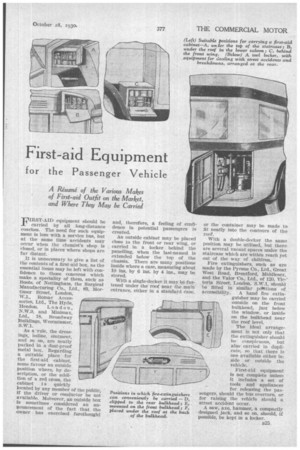First-aid Equipment
Page 123

If you've noticed an error in this article please click here to report it so we can fix it.
for the Passenger Vehicle
A Resume' of the Various Makes of First-aid Outfit on the Market, and Where They May be Carried
FIRST-AID equipment should he carried by all long-distance coaches. The need for such equipment is less with a service bus, but at the same time accidents may occur when the chemist's shop is Closed, or in places where shops are far distant.
It is unnecessary to give a list of the contents of a first-aid box, as the essential items may be left with confidence to those concerns which make a speciality of them, such as Boots, of Nottingham, the Surgical Manufacturing Co., Ltd., 83, Mortimer Street, London, W.1., Romac Accessories, Ltd., The Hyde, Hendon, London, N.W.9, and Minimax, Ltd., 18, Broadway Buildings, Westminster, S.W.1.
As Fr-rule, the dressings, iodine, ointment, and so on, are neatly paeked in a dust-proof metal box. Regarding a suitable place for the first-aid cabinet, some favour an outside position where, by description, or the addition of a red cross, the cabinet is quickly located by any member of the public, if the driver or conductor be not available. Mdi.eover, an outside box is sometimes considered an announcement of the fact that the owner has exercised forethought
and, therefore, a feeling of confidence in potential passengers is created.
An outside cabinet may be placed close to the front or rear wing, or carried in a locker behind the panelling, when the last-named is extended below the top of the chassis. There are many positions inside where a case, measuring about 10 ins. by 6 ins. by 4 ins., may be. stored.
With a single-decker it may be fastened under the roof near the main entrance, either in a standard case,
(Left) Suitable positions for carrying a first-aid cabinet—A, under the top of the staircase ; B, under the roof in the lower saloon ; C, behind the front wing. (Below) A tool locker, with equipment for dealing with street accidents and
breakdowns, arranged at the rear.
or the container may be made to fit neatly into the contours of the roof.
With a double-decker the same position may be utilized, but there are several vacant spaces under the staircase which are within reach yet out of the way of children.
Fire extinguishers, such as are made by the Pyrene Co., Ltd., Great West Road, Brentford, Middlesex, and the Valor Co., Ltd.. of 120, Victoria Street, London, S.W-1, should be fitted in similar pdPitions of accessibility. A hand fire extin guisher may be carried outside on the front bulkhead, just below the window, or inside on the bulkhead near the roof level.
The ideal arrange ment is not only that the extinguisher should be conspicuous, but also carried in duplicate, so that there is one available either inside or outside the vehicle.
First-aid equipment is not complete unless it includes a set of tools and appliances for releasing the pas sengers, should the bus overturn, or for raising the vehicle should a street accident occur.
A saw, axe, hammer, a compactly designed jack, and so on, should, if possible, be kept in a locker.




















































































































































































